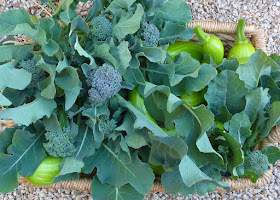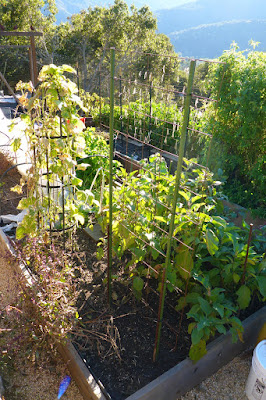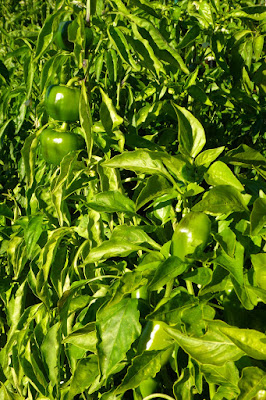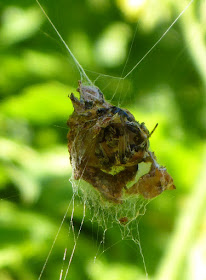It has been AGES since I did a garden tour, the end of June to be precise. I thought I would take one last look around before we have a freeze that knocks all the remaining tender plants out of production. There was a freeze warning the other night for the general area but not for my particular location, but it reminded me that the garden can change in a snap at this time of year.
It looks a bit like a jungle as you enter. The Tromba D'Albenga squash vines have rambled all over one corner of Bed #4 and on down the path as well. They started wending their way through the spent Taos Pueblo Blue corn plants and have nearly taken over the trellis for the Monachelle di Trevios beans beyond. That's just two vines! And I've been snipping the ends off the vines that are pushing too far.
Here's a slightly different perspective from early July.
 |
| July 10 |
The Spigariello broccoli in the corner of the bed on the left is still there. This particular plant has had no inclination to bloom so I've let it continue to grow, although I have cut off numerous side shoots as they have gotten in the way. The other two Spigariello plants started blooming and also became full of aphids so they hit the compost long ago.
This plant has remained relatively aphid free and since I never got around to setting out the kale that I started for fall/winter production this plant will stand in for the kale.
The leeks that I had hoped to harvest through the winter are pathetic. This is after going through and stripping down all the dead rust infected leaves. What's not obvious is that a number of them have also bolted. My leek growing days are over. I'm going to pull all of these and get some winter salad greens going - cress, arugula, mizuna, maybe some Ethiopian Highland kale.
I did plant out other fall/winter brassicas into this bed. I love the big brilliant green spiral heads of Romanesco broccoli and always try to grow it, not always successfully. So far they are looking good. These don't usually produce heads until sometime in January or so, but in the meantime the plants get huge.
 |
| Romanesco broccoli |
The Brussels Sprouts have finally started to size up. This is my first attempt at growing them in many years and so far they look better than anything I've grown before. Still pretty puny though...
 |
| Gustus Brussels Sprouts |
I'm having another go at the Sicilian Violet cauliflower that I grew this spring with mixed results (huge funky heads). The plants are getting to be huge and even though the leaves at the centers of the plants are becoming more straplike (which I've observed indicates that flower heads are starting to form) I don't see any tiny heads yet. I may go back to the Amazing Taste classic white cauliflower that did so well for me last year, they aren't such space hogs.
 |
| Sicilian Violet cauliflower |
Broccoli, broccoli, broccoli - what was I thinking?! Here's 3 new Di Ciccio broccoli plants. And between these plants and the brussels sprouts are 3 plants each of Batavia broccoli and Apollo brokali. And between the brussels sprouts and Spigariello (passing for kale) broccoli are a couple more Batavia and Di Ciccio broccoli plants that I've not had the heart to pull because they keep producing. It's a good thing that we really like broccoli.
Around the other side of the Di Ciccio broccoli is a very late planting of celery and celeriac. My first attempt at getting seedlings going failed so I tried again. I really don't have anything to lose by setting them out, they are quite cold hardy and have grown fairly well so far so perhaps I'll get a bit of a crop. It's not like I can't spare the space at this time of year (same goes for that huge cauliflower).
 |
| Monarch celeriac and Dorato D'Asti celery |
That's it for Bed #1. Bed #2 is nearly done producing for the year. I haven't gotten around to removing the trellis that the fabulous Honey Nut Butternut squash climbed through the summer. The cucumber vines need to go also. And it's finally time to take out the eggplants. Some of the eggplants look amazingly healthy and are even blooming, but they don't stand a chance of producing anything new so they need to make way for a winter cover crop of mustard.
There's only a couple of other things left in this bed including some beets, most of which are about ready to harvest. And the strawberry plants linger, even after I cut them down to their crowns which just prompted them to regrow. Planting them in a block at the end of the bed didn't work out. The area doesn't get enough air circulation so the plants and berries were full of fungal infections. If I grow strawberries again it will be in containers.
The other crop left in Bed #2 is a small patch of Gladiator parsnips. I nearly gave up on these. A lot of the seedlings were munched by bugs and the survivors were really slow to grow. But now they seem to be happy. A few pokes around the soil line seems to indicate some decent sized roots have started to develop. I hope it's not just fat tops and skinny roots...
I need to get Bed #2 cleaned out by the end of the year. This will be the tomato and pepper bed next year and I like to grow a mustard cover crop that I'll dig in as a green manure before I set out the tomato and pepper plants. The cover crop grows through the winter and then gets dug in a couple months before the tomatoes and peppers go in.
Bed #3 has been the tomato and pepper bed for 2015. I've left the cherry tomato plants since they have been producing just a few little fruits now and then and Dave has been enjoying them. The rest of the tomato plants have been removed. I've not been terribly motivated to get things done in the garden this fall. I had meant to get an early start on some favas and sow some seeds where the tomato plants had been removed, but not gotten around to it. So the tomatoes are basically done, but the peppers are still going. When we had the freeze warning the other night I decided to clear out all of the ripe and ripening peppers. Egads, the kitchen counters are covered again, just when I was starting to catch sight of them.
There's still quite a few green peppers coming along. I'm not sure what I'll do with them. Some of them are tasty green, but others, like green bell peppers aren't to my liking. A surprise frost would take care of things for me...
One of the things I love about gardening is watching the critters that inhabit the garden. I was surprised to see a couple of ladybugs in the peppers, it's been cold lately so I thought they would be in a cozy winter hiding spot by now.
I think that this is a Trash Line spider. It's spun its web in the tomato plants. These spiders create a line of "trash" composed of the carcasses of their prey, webbing, and other debris. They hide in the trash line and pounce on unwitting prey that happens by.
Back to Bed #4. The Tromba D'Albenga squash is working its way along the other side of the bed.
There's actually some late planted melon vines in the mix - no hope of anything ripening in there. Another spot to clear out. This is where I'll be growing onions next year. I just placed a couple of orders for seeds for new varieties that I'm going to trial. I have to get the seeds started now so that I have some good sized seedlings ready to plant out in January. I'm not going to be placing a Dixondale order this year. They only have the three-some of intermediate day-length onions and it turns out that 2 of the 3 don't do well for me and I don't need a full bundle of the one that does well.
I set out my garlic on October 23 and it is already emerging, you can see some of the little green shoots in the photos above and below.
By the way, the Tromba squash is making good use of its space, it's already produced 10 pounds of squash this month and 68 pounds so far this year.
There's one more up-and-comer in this bed, or would be if I gave it the attention it requires. I managed to get some Golden Sweet Snow peas and some Super Sugar Snap peas going. But I need to give them some better protection, they are busting out of the cover that I put up to keep the birds from destroying them - what is poking out is already getting eaten.
That's the garden in early November. It has escaped frost so far and has been enjoying some pretty regular but not too heavy doses of rain. The weeds are already sprouting in the path. And somehow I just don't care too much. I think I'm getting a bit burnt out by the demands of my year round garden. There's no way I can give it up, but maybe next year I'll scale back. Maybe... the seed catalogs haven't started to arrive yet.




















































